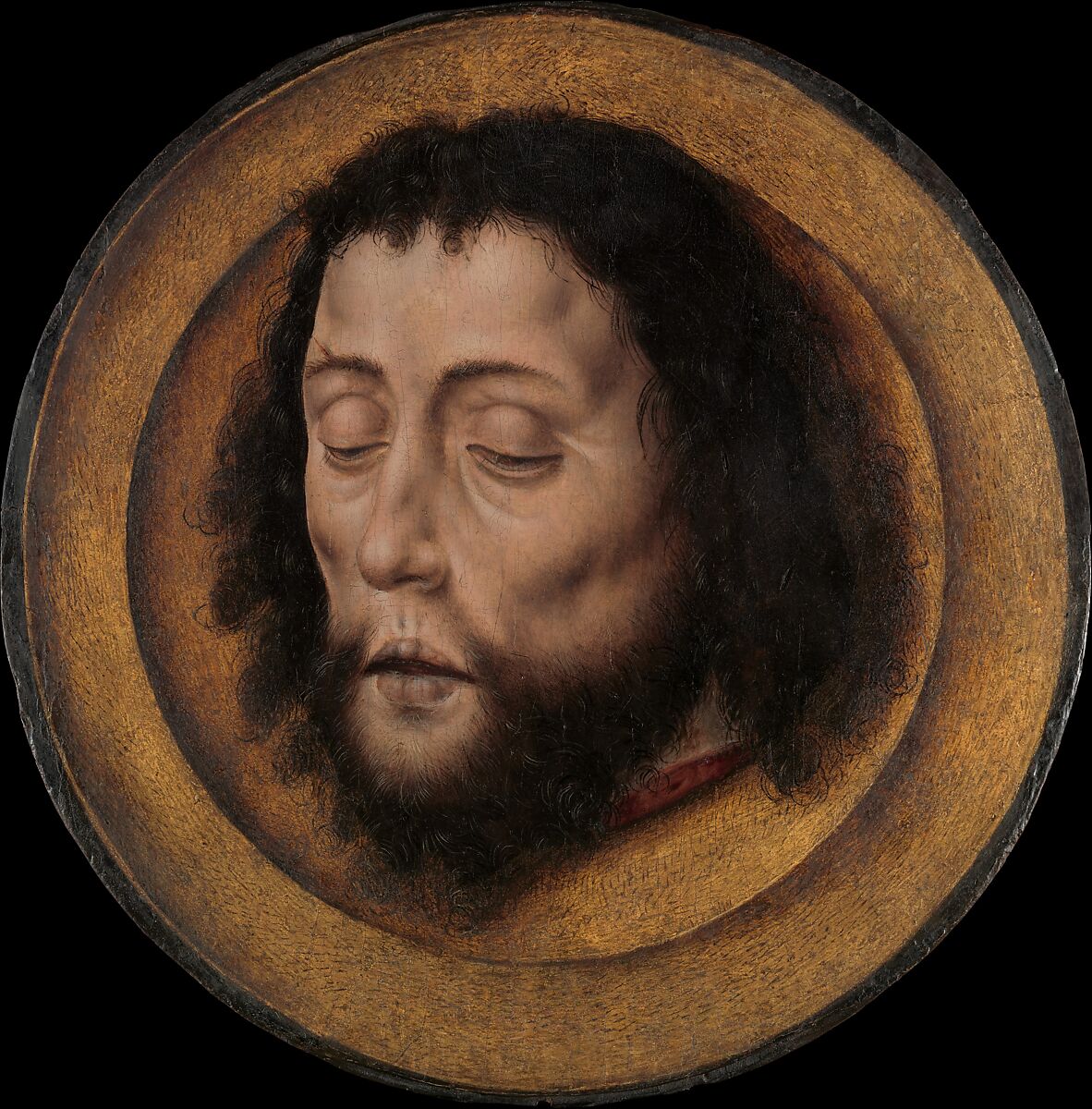Никола Бенин

Bouts, Albrecht (1451 / 1455-1549) (and workshop)
Head of St. John the Baptist - circa 1500
oil and tempera on panel 30.5 cm
National Museum in Warsaw
Tondo from the workshop of Aelbert Bouts, depicts the head of Saint John the Baptist cut from the order of Herod. It rests on an undefined blue background, limited by a golden circle - unlike in the other dozen or so well-known versions of the painting, which show it on an illusionistically captured, gold-plated , casting a shadow on the metal surface. Here the composition can be interpreted in two ways: either as a plate on which Salome brought the head of the martyr, or as a halo surrounding the head of the saint. The theme has its source in the Gospel of Saint. Matthew (14, 6-12) and Saint. Mark (6, 21-29). Together with the growing cult of Saint John the Baptist after bringing in the 120th year (after the fourth crusade) relics of the Holy skull, from the thirteenth century it was popularized in Western art, first in sculpture, then in painting. realistically, almost portraits of a dead face, almost portrayed, were facilitated by the contemplation of the saint's image as an image intended for private piety, according to the formula of devotio moderna propagated in the late Middle Ages - deep, empathetic meditation of the mysteries of faith. Especially that the head of St. John on the bear was considered a symbolic announcement of the Eucharistic sacrifice of Christ. This is one of the 23 surviving versions of a nonexistent composition, whose authorship is most likely to be attributed to Dirk I Bouts, father of Aelbert. Most of these tonds were created in Aelbert Bouts's workshop. Henderiks (2011) defines the Warsaw version as a result of Aelbert's cooperation (a preparatory sketch visible even with the naked eye) and assistant in his workshop (painting layer) and places the work in a group of three versions, for a prototype for them, recognizing the image from around 1500. in the collection of the Landsemuseum Augusteum in Oldenburg.
Head of St. John the Baptist - circa 1500
oil and tempera on panel 30.5 cm
National Museum in Warsaw
Tondo from the workshop of Aelbert Bouts, depicts the head of Saint John the Baptist cut from the order of Herod. It rests on an undefined blue background, limited by a golden circle - unlike in the other dozen or so well-known versions of the painting, which show it on an illusionistically captured, gold-plated , casting a shadow on the metal surface. Here the composition can be interpreted in two ways: either as a plate on which Salome brought the head of the martyr, or as a halo surrounding the head of the saint. The theme has its source in the Gospel of Saint. Matthew (14, 6-12) and Saint. Mark (6, 21-29). Together with the growing cult of Saint John the Baptist after bringing in the 120th year (after the fourth crusade) relics of the Holy skull, from the thirteenth century it was popularized in Western art, first in sculpture, then in painting. realistically, almost portraits of a dead face, almost portrayed, were facilitated by the contemplation of the saint's image as an image intended for private piety, according to the formula of devotio moderna propagated in the late Middle Ages - deep, empathetic meditation of the mysteries of faith. Especially that the head of St. John on the bear was considered a symbolic announcement of the Eucharistic sacrifice of Christ. This is one of the 23 surviving versions of a nonexistent composition, whose authorship is most likely to be attributed to Dirk I Bouts, father of Aelbert. Most of these tonds were created in Aelbert Bouts's workshop. Henderiks (2011) defines the Warsaw version as a result of Aelbert's cooperation (a preparatory sketch visible even with the naked eye) and assistant in his workshop (painting layer) and places the work in a group of three versions, for a prototype for them, recognizing the image from around 1500. in the collection of the Landsemuseum Augusteum in Oldenburg.
Няма коментари:
Публикуване на коментар